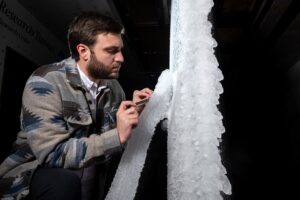NewzVille Science Desk
Research and development is going on at National Aeronautics and Space Administration (NASA) on how to save fuels in airline sector. In the future, aircraft with long, thin wings supported by aerodynamic braces could help airlines save on fuel costs. But those same wings could be susceptible to ice buildup. NASA researchers are currently working to determine if such an issue exists, and how it could be addressed.
In the historic Icing Research Tunnel at NASA’s Glenn Research Center in Cleveland, scientists and engineers are testing a concept for a transonic truss-braced wing. Their goal: to collect important data to inform the design of these potential efficient aircraft of the future.

A transonic truss-braced wing generates less drag in flight compared to today’s aircraft wings, requiring an aircraft to burn less fuel.
This revolutionary design could make the wing more prone to ice buildup, so it must undergo a series of rigorous tests to predict its safety and performance. The data the research team has collected so far suggests large sections of the front most part of the wing (also known as the leading edge) will require an ice protection system, similar to those found on some commercial aircraft.
NASA Glenn can simulate icing conditions in its Icing Research Tunnel to identify potential challenges for new aircraft designs. These tests provide important information about how ice builds up on wings and can help identify the most critical icing conditions for safety. All commercial aircraft must be approved by the Federal Aviation Administration to operate in all kinds of weather.
This research is part of NASA’s work to mature transonic truss-braced technology by looking at issues including safety and how future aircraft could be integrated into U.S. aviation infrastructure. Boeing is also working with NASA to build, test, and fly the X-66, a full-sized demonstrator aircraft with transonic truss-braced wings. Because the experimental aircraft will not be flown in icy conditions, tests in the Icing Research Tunnel are providing answers to questions about ice buildup.
This work advances NASA’s role in developing ultra-efficient airliner technologies that are economically, operationally, and environmentally sustainable. For about two decades, NASA has invested in research aimed at advancing transonic truss-braced wing technology to the point where private sector aeronautics companies can integrate it into commercial aircraft configurations.
NASA invests in this research through initiatives including its Advanced Air Transport Technology project, which investigates specific performance aspects of transonic truss-braced wing concepts, such as icing. The Advanced Air Transport Technology project is part of NASA’s Advanced Air Vehicles Program.



